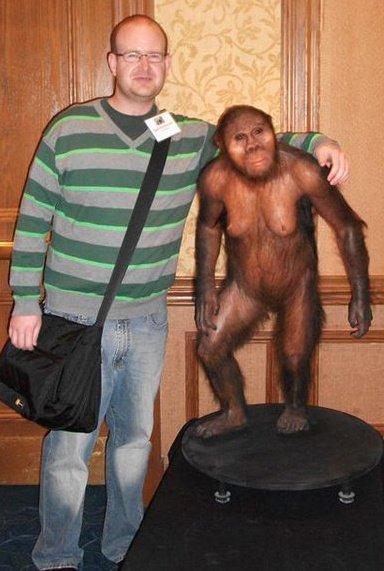
September 14, 2012
Guy Edwards posted on September 7, 2012, this, “Look Out Meldrum, There’s Another Bigfoot Anthropologist in Town.”
Edwards’ posting was about anthropologist Zach Throckmorton (shown below, with a friend).

I posted, in two comments, some ponderings (framed, with my apologies, in my dislike for the use of the word “pseudoscience,” I’m sure). I did this in the comments section, after reading Edwards’ quick essay:
“Why would anyone who is not a scoftic or debunker, even if they are excluding Sasquatch studies from the labeled area, use the term ‘pseudoscience,’ unless they accept the political-emotional parameters that are part of using that word?”
and
“He probably uses ‘pseudoscience’ and the conceptual emotional barrage of that word because his advisor is John Hawks who *seems* to have a harsh pseudoscientific view of Bigfoot.”
I was just poking into the darkness, looking for non-scholarly answers, with no disrespect to him or John Hawks, whose anthropology blog I very much appreciate.
Zach wrote back.
Here’s his reply:
Loren
I’ve followed your work for years and am sympathetic that your work is often dismissed unreasonably by close-minded academics.
* * *
I’d be happy to discuss how my research on variability in the modern human foot arch relates to work on Bigfoot. I’m also working on a paper about hallucal abduction that’s relevant to the discussion. I’d also be happy to discuss scientific and pseudoscientific approaches to work on Bigfoot. You questioned why I would use the term “pseudoscience” to describe cryptozoology in general (and Bigfoot in particular), if I am not a debunker, and insinuated I use that term because my adviser uses that term. I think there is usually a clear delineation between good science and laughable pseudoscience. Cryptozoology is burdened with pseudoscientific baggage, which is why it is generally dismissed by mainstream science. I think this is unfortunate, because there is also a lot of excellent, rigorous scientific work on cryptids that deserves attention. As an anthropologist, I give weight to stories and oral traditions of creatures like the orang pendek and the legion of stories about men of the wilds from all over the world. I think it is important to be skeptical and to keep an open mind on (some) cryptids, such as Bigfoot.Zach Throckmorton
About Loren Coleman
Loren Coleman is one of the world’s leading cryptozoologists, some say “the” leading living cryptozoologist. Certainly, he is acknowledged as the current living American researcher and writer who has most popularized cryptozoology in the late 20th and early 21st centuries.
Starting his fieldwork and investigations in 1960, after traveling and trekking extensively in pursuit of cryptozoological mysteries, Coleman began writing to share his experiences in 1969. An honorary member of Ivan T. Sanderson’s Society for the Investigation of the Unexplained in the 1970s, Coleman has been bestowed with similar honorary memberships of the North Idaho College Cryptozoology Club in 1983, and in subsequent years, that of the British Columbia Scientific Cryptozoology Club, CryptoSafari International, and other international organizations. He was also a Life Member and Benefactor of the International Society of Cryptozoology (now-defunct).
Loren Coleman’s daily blog, as a member of the Cryptomundo Team, served as an ongoing avenue of communication for the ever-growing body of cryptozoo news from 2005 through 2013. He returned as an infrequent contributor beginning Halloween week of 2015.
Coleman is the founder in 2003, and current director of the International Cryptozoology Museum in Portland, Maine.
Filed under CryptoZoo News, Cryptozoology